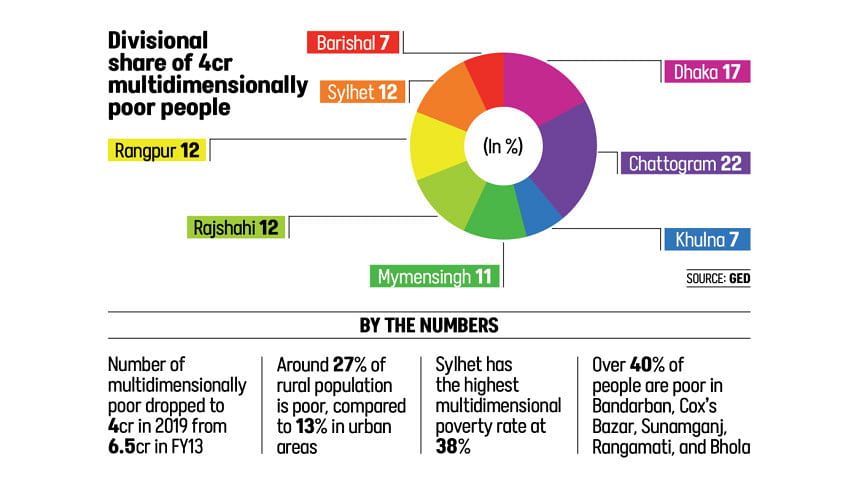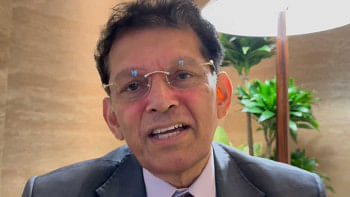4 crore people face multidimensional poverty

More than four crore people in Bangladesh are trapped in multidimensional poverty, a form of deprivation that goes beyond income and includes limited access to education, healthcare, and basic living conditions.
The figure, revealed in the country's first Multidimensional Poverty Index (MPI), shows that the rate of such poverty is higher than income poverty.
The index has been developed by the General Economics Division (GED) using data from the 2019 Multiple Indicator Cluster Survey and was published yesterday. The multidimensional poverty rate was 24 percent of the population that year.
Although based on pre-Covid data, a senior GED official said the current rate of multidimensional poverty is likely to be higher than the income poverty rate of 18.7 percent estimated in 2022.
Poverty is not just about not having money. Rather, it is like being stuck in a maze with multiple locked doors. Even if someone has a little cash, they still might not have access to essential services like schools, healthcare, clean water, or electricity.
The index offers a broader view of deprivation by assessing three key dimensions: education, health, and living standards.
A person is considered multidimensionally poor if they are deprived in at least one-third of the weighted indicators.
Living standards are measured through gauges such as access to electricity, sanitation, drinking water, housing, cooking fuel, assets, and internet.
Education includes school attendance and years of schooling, while health is assessed through nutrition and reproductive health.
The new data show that while multidimensional poverty still affects a large portion of the population, the number of people experiencing hunger and other forms of deprivation declined by around 2.5 crore—from 6.5 crore in 2012-13 to 4 crore in 2019.
GED Member Monzur Hossain said that the findings are still relevant for policymaking, even though they are based on data from 2019.
"It shows that the multidimensional poverty rate was higher than income poverty. So, it can be assumed that the multidimensional poverty rate is expected to be higher than the income poverty estimated in 2022," he said.
"It has policy relevance. There is a district-wise variation between income and multidimensional poverty levels. Targeted policies and interventions can be taken in districts where the multidimensional poverty rate is high," Hossain added.
Hossain, a former research director at the Bangladesh Institute of Development Studies (BIDS), said public investments and social protection programmes could be tailored using MPI data.
In a written statement, Professor Wahiduddin Mahmud, adviser to the Ministry of Planning, said, "MPI as a multidimensional approach can better guide the design of impactful development programs and services."
He described the index as an "innovative tool" to pinpoint disadvantaged groups and regions in the drive to eradicate poverty and meet the Sustainable Development Goals (SDGs).
A breakdown of the 2019 data by age shows that children are particularly vulnerable. Around 29 percent of those under 18 live in multidimensional poverty, compared to 21 percent of adults.
Still, the situation has improved significantly for children. In 2012-13, half of all children under 18 were multidimensionally poor. By 2019, this had fallen to 29 percent, lifting roughly 1.3 crore children out of deprivation.
The report attributes this progress to improvements in electricity coverage, housing, asset ownership, and sanitation—outcomes it links to targeted efforts across social services and infrastructure.
Urban areas fare better than their rural counterparts. Just 13 percent of the urban population is considered multidimensionally poor, compared to 27 percent in rural areas.
Poverty rates also vary sharply by division. In Khulna, 15 percent of the population is multidimensionally poor, while the rate stands at 38 percent in Sylhet.
The disparity is even sharper at the district level, as only 9 percent of people in Jhenaidah fall under this category, while in Bandarban, it rises to 65 percent.
A highly visible form of deprivation is poor housing. Roughly 21 percent of the population does not have improved floors, roofs, or walls and is counted as multidimensionally poor due to inadequate shelter.
Among the weighted indicators, child school attendance contributes the most to the national MPI, followed by years of schooling, nutrition, and housing.
Three indicators—housing, internet access, and sanitation—show high levels of deprivation nationwide. In each category, more than 20 percent of people are poor by MPI standards.
The report suggests that, alongside educational investments, government efforts should focus on improving access to housing, sanitation, and connectivity to reduce multiple forms of deprivation affecting millions.
It calls for geographical targeting, urging immediate government support in districts with the highest MPI rates.
In Bandarban, for instance, 65 percent of residents are classified as MPI poor. This stands at 47 percent in both Cox's Bazar and Sunamganj.
The report also recommends identifying and prioritising sectors that demand urgent attention. Addressing educational deprivation, especially school attendance and years of schooling, is key to reducing multidimensional poverty nationwide.
GED collaborated with the Bangladesh Bureau of Statistics (BBS), Unicef Bangladesh, and the Oxford Poverty and Human Development Initiative (OPHI) for the MPI publication.

 For all latest news, follow The Daily Star's Google News channel.
For all latest news, follow The Daily Star's Google News channel. 



Comments